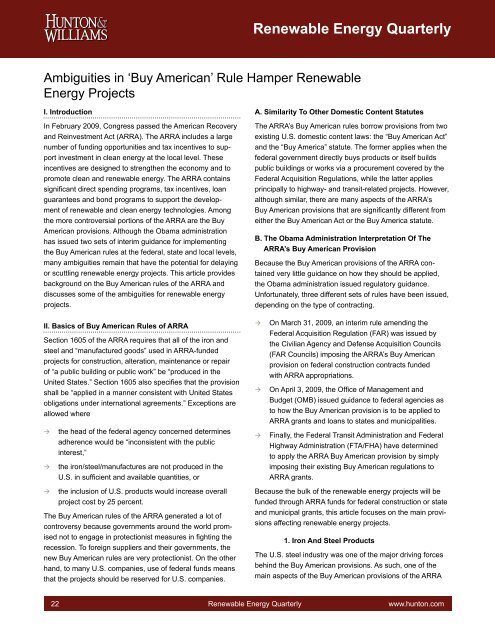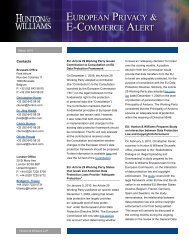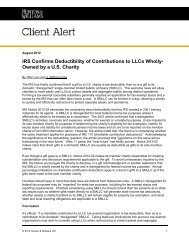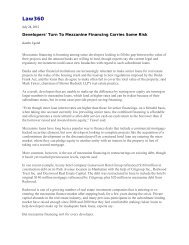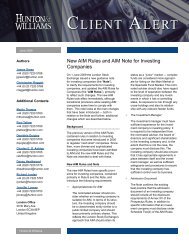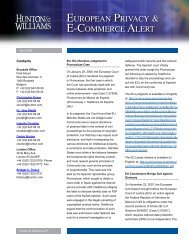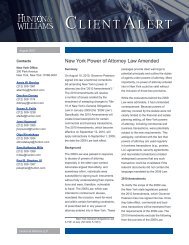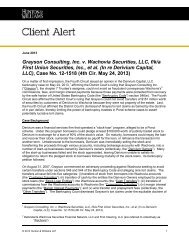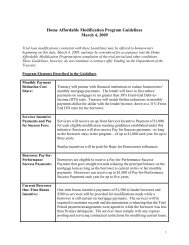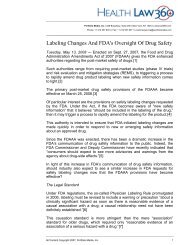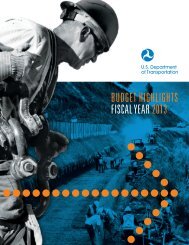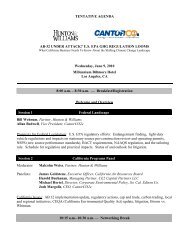Hunton & Williams Renewable Energy Quarterly, September 2009
Hunton & Williams Renewable Energy Quarterly, September 2009
Hunton & Williams Renewable Energy Quarterly, September 2009
Create successful ePaper yourself
Turn your PDF publications into a flip-book with our unique Google optimized e-Paper software.
<strong>Renewable</strong> <strong>Energy</strong> <strong>Quarterly</strong><br />
Ambiguities in ‘Buy American’ Rule Hamper <strong>Renewable</strong><br />
<strong>Energy</strong> Projects<br />
I. Introduction<br />
In February <strong>2009</strong>, Congress passed the American Recovery<br />
and Reinvestment Act (ARRA). The ARRA includes a large<br />
number of funding opportunities and tax incentives to support<br />
investment in clean energy at the local level. These<br />
incentives are designed to strengthen the economy and to<br />
promote clean and renewable energy. The ARRA contains<br />
significant direct spending programs, tax incentives, loan<br />
guarantees and bond programs to support the development<br />
of renewable and clean energy technologies. Among<br />
the more controversial portions of the ARRA are the Buy<br />
American provisions. Although the Obama administration<br />
has issued two sets of interim guidance for implementing<br />
the Buy American rules at the federal, state and local levels,<br />
many ambiguities remain that have the potential for delaying<br />
or scuttling renewable energy projects. This article provides<br />
background on the Buy American rules of the ARRA and<br />
discusses some of the ambiguities for renewable energy<br />
projects.<br />
II. Basics of Buy American Rules of ARRA<br />
Section 1605 of the ARRA requires that all of the iron and<br />
steel and “manufactured goods” used in ARRA-funded<br />
projects for construction, alteration, maintenance or repair<br />
of “a public building or public work” be “produced in the<br />
United States.” Section 1605 also specifies that the provision<br />
shall be “applied in a manner consistent with United States<br />
obligations under international agreements.” Exceptions are<br />
allowed where<br />
ÆÆ the head of the federal agency concerned determines<br />
adherence would be “inconsistent with the public<br />
interest,”<br />
ÆÆ the iron/steel/manufactures are not produced in the<br />
U.S. in sufficient and available quantities, or<br />
ÆÆ the inclusion of U.S. products would increase overall<br />
project cost by 25 percent.<br />
The Buy American rules of the ARRA generated a lot of<br />
controversy because governments around the world promised<br />
not to engage in protectionist measures in fighting the<br />
recession. To foreign suppliers and their governments, the<br />
new Buy American rules are very protectionist. On the other<br />
hand, to many U.S. companies, use of federal funds means<br />
that the projects should be reserved for U.S. companies.<br />
A. Similarity To Other Domestic Content Statutes<br />
The ARRA’s Buy American rules borrow provisions from two<br />
existing U.S. domestic content laws: the “Buy American Act”<br />
and the “Buy America” statute. The former applies when the<br />
federal government directly buys products or itself builds<br />
public buildings or works via a procurement covered by the<br />
Federal Acquisition Regulations, while the latter applies<br />
principally to highway- and transit-related projects. However,<br />
although similar, there are many aspects of the ARRA’s<br />
Buy American provisions that are significantly different from<br />
either the Buy American Act or the Buy America statute.<br />
B. The Obama Administration Interpretation Of The<br />
ARRA’s Buy American Provision<br />
Because the Buy American provisions of the ARRA contained<br />
very little guidance on how they should be applied,<br />
the Obama administration issued regulatory guidance.<br />
Unfortunately, three different sets of rules have been issued,<br />
depending on the type of contracting.<br />
ÆÆ On March 31, <strong>2009</strong>, an interim rule amending the<br />
Federal Acquisition Regulation (FAR) was issued by<br />
the Civilian Agency and Defense Acquisition Councils<br />
(FAR Councils) imposing the ARRA’s Buy American<br />
provision on federal construction contracts funded<br />
with ARRA appropriations.<br />
ÆÆ On April 3, <strong>2009</strong>, the Office of Management and<br />
Budget (OMB) issued guidance to federal agencies as<br />
to how the Buy American provision is to be applied to<br />
ARRA grants and loans to states and municipalities.<br />
ÆÆ Finally, the Federal Transit Administration and Federal<br />
Highway Administration (FTA/FHA) have determined<br />
to apply the ARRA Buy American provision by simply<br />
imposing their existing Buy American regulations to<br />
ARRA grants.<br />
Because the bulk of the renewable energy projects will be<br />
funded through ARRA funds for federal construction or state<br />
and municipal grants, this article focuses on the main provisions<br />
affecting renewable energy projects.<br />
1. Iron And Steel Products<br />
The U.S. steel industry was one of the major driving forces<br />
behind the Buy American provisions. As such, one of the<br />
main aspects of the Buy American provisions of the ARRA<br />
22 <strong>Renewable</strong> <strong>Energy</strong> <strong>Quarterly</strong> www.hunton.com


